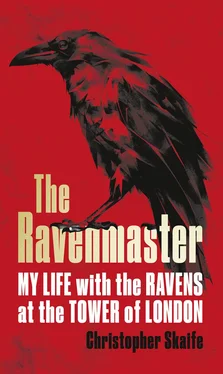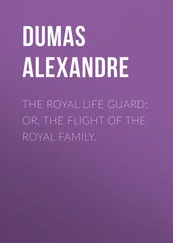And speaking of caching, the next thing I do every morning is take care of the foxes.
If there’s one thing I’ve learned in a life dealing with animals, it’s this: there are always foxes to be taken care of.
8
As Ravenmaster, I see myself as responsible for all the wildlife in the Tower – including the foxes. What I’ve tried to do here over the years is to create a balance between everyone’s competing needs: the ravens, the foxes, the Yeoman Warders, the visitors. We all share the environment of the Tower, and my job is really about finding ways to enable us to live in harmony together. Most of the time all it requires is a little bit of forethought and some careful husbandry. If you leave food lying around, for example – guess what? – the foxes come in where you don’t want them, and they can cause absolute havoc. In the old days we’d just catch and cage them and take them away for extermination, but my feeling is that they have almost as much right to be here as the rest of us.
In order to maintain our modest little ecosystem, every morning after I’ve fed the ravens I take any scraps of food to the fox cache. A cache is a hiding place for ammunition, food, or indeed treasure of any sort. In the army we were taught to set up caches in evasion and recovery operations, storing food and water, medical items, communication equipment, that sort of thing. I decided to set up the fox cache a few years ago when I realised that the best way to manage the foxes in the Tower was to try to think like a fox. It’s that old military thing: know your enemy. With foxes you have to understand that they really just want to come and fill their bellies, and then they’re happy, and they’ll leave you alone. So I found a special place where I can deliver food to them every day, which keeps them contented and well away from the ravens’ enclosure. Job done.
(And how did I know the best place to leave the food for the foxes, you might ask. Well, I probably know every nook and cranny in the Tower, every rooftop and gutter, every walkway, every staircase, every little crack and fissure. Wherever it is, however high or low, however inaccessible, I’ve been there, found the ravens hiding there, found something they’ve hidden there, or found a foxhole or a nest or a den or a warren. Visitors are always asking about hidden tunnels in the Tower. All I can say is that I’ve never discovered any – and I’ve been looking for years.)
The Tower throughout its history has always been full of all sorts of animals. These days a lot of those animals are the cats and dogs and other pets of the Yeoman Warders – you’d be surprised how many of us are out early in the morning walking our dogs in the moat. Apart from the ravens and the foxes there are also the various squirrels, seagulls, pigeons, sparrows, starlings, kestrels, blue tits, crows, mice, rats, and even the odd pair of Egyptian geese that like to stop over and drink from the ravens’ water bowls. The Tower is an eighteen-acre green oasis in the middle of London, after all. We have a breeding pair of kestrels in one of the arrow slits opposite my house in the Casemates, who have been resident now for many years; we have four different kinds of bats; and every year when Traitors’ Gate is full of water we usually get a duck family settling in with their ducklings. Two magpies, who I call Ronnie and Reggie Kray after the notorious 1960s London gangsters, like to visit the ravens’ enclosure looking for scraps of leftover meat, and seem to have been accepted by them – perhaps on the threat of violence, who knows.
Until relatively recently, though, most of the animals in the Tower would have been the exotic beasts presented by the rulers of faraway lands to the kings and queens of England. For more than six hundred years the Tower was a sort of zoo, or at least a storehouse for rare creatures of all kinds, which were an entertainment and a spectacle for visitors. In a sense, the ravens are another chapter in the great Royal Menagerie story, and the Ravenmaster is a keeper of one of the world’s few single-species open-air zoos.
The term menagerie – which I like to use to refer to all of us who live and work together in the Tower – derives from the French, and refers to an aristocratic or royal collection of captive animals. As every schoolchild knows, when William the Conqueror invaded in 1066 he ordered that a series of fortresses be built around England to protect his barons from the threat of invading armies and civil dissent – among which fortresses the Tower is only the most famous and the most long-standing. According to the Domesday Book, the Normans founded nearly fifty castles in the twenty years after landing at Hastings, a building programme unprecedented in English history, and which makes even the current property boom in London seem not so much a bang as a whimper. What’s perhaps less well-known is that William’s son Henry established England’s first menagerie at his manor house in Oxford, building a big wall to contain his collection of lions, camels and porcupines. This small royal zoo was eventually moved to the Tower around 1204, during the reign of King John, and formed the beginning of the Royal Menagerie.
There have always been famous animals who have called London home. When I was growing up it was the giant pandas Chi Chi and Ching-Ching and Guy the gorilla at London Zoo. Earlier in the twentieth century there was Winnie, the female Canadian black bear who would give her name to young Christopher Robin Milne’s teddy bear, the inspiration for Winnie-the-Pooh. And back in the nineteenth century there was the mighty Obaysch, the first hippo in Europe since the days of the Roman Empire, who caused a sensation: Queen Victoria came to watch him swimming in Regent’s Park, and compared him to a porpoise. But before all of them there were the animals of the Tower, the bigger and stranger the better.
There was a ‘white bear’ – a polar bear – for example, who was a gift from King Haakon IV of Norway to King Henry III in 1252, and who was kept tethered at the riverside with a huge collar and a long rope, allowing him to fish for food in the Thames. I like to imagine the look on the faces of anyone who happened to be sailing up or down the river when they saw a big white bear swimming past. In addition, in 1255 Louis IX of France gave Henry III an African elephant. Just getting it to London must have been a logistical nightmare. According to one eyewitness, ‘the people flocked to see the novel sight … The beast is about ten years old, possessing a rough hide rather than fur, has small eyes at the top of its head, and eats and drinks with a trunk.’ Again, what a sight, to have seen an elephant at the Tower back then – I would compare it today to seeing a Tyrannosaurus rex suddenly poking its head over the battlements.
Like any great collection, the Royal Menagerie just grew and grew. By the time Edward I came to the throne, an official position had been created known as Keeper of the Lions and Leopards, later renamed the Master of the King’s Bears and Apes. By the 1300s all the animals in the Tower had to be moved outside to the main western entrance, which was later named the Lion Tower, for obvious reasons.
An ‘Extraordinary and Fatal Combat’ that took place at the Royal Menagerie at the Tower in December 1830. The lion died of its injuries. (Heritage Image Partnership Ltd/Alamy Stock Photo)
Конец ознакомительного фрагмента.
Текст предоставлен ООО «ЛитРес».
Прочитайте эту книгу целиком, купив полную легальную версию на ЛитРес.
Читать дальше












